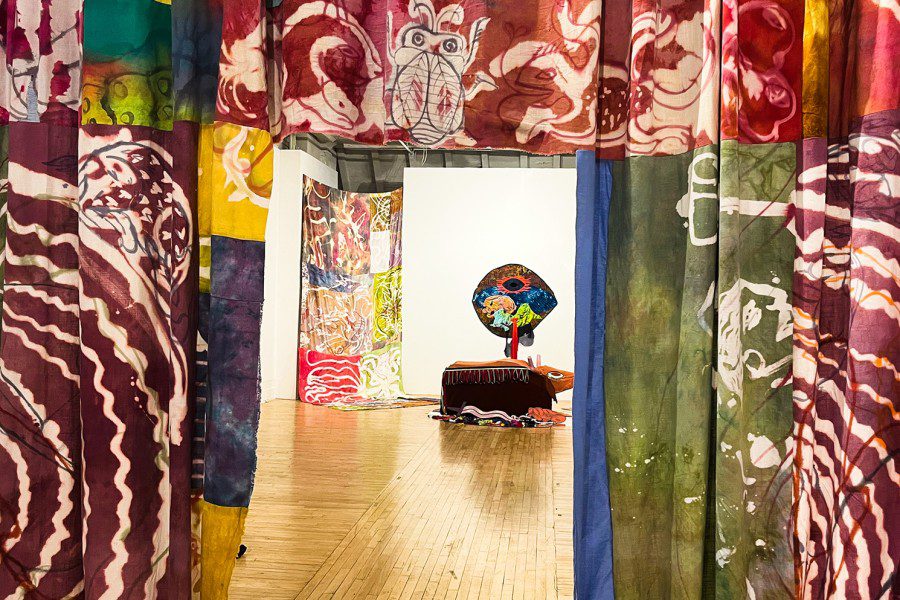Review: ‘What A Glory to Be So Euphoric and Weak’ is simply executed but deeply meaningful
A small exhibit featuring colorful creations envelops La MaMa Galleria with layered textiles, chaotic patterns and organic introspection.
Tura Oliveira’s new exhibition “What A Glory to Be so Euphoric and Weak” is available at La MaMa Galleria. (Madeline Kane for WSN)
October 12, 2022
Content warning: This article contains descriptions of body dysmorphia.
Nestled a few blocks away from NYU’s Washington Square campus, La MaMa Galleria displayed an intimate art installation by Brooklyn-based interdisciplinary artist Tura Oliveira. The show, “What A Glory to Be So Euphoric and Weak,” is the first show of Oliviera’s that blends performance art with textile pieces.
The front desk welcomes the viewer with a long, thin reclaimed cotton sculpture as linen sheets trail down from the ceiling to the floor across a long, 25-foot-tall passageway. This striking entrance enables the viewer to enter Oliveira’s whimsical and layered world. Despite being a tiny white-walled gallery, the La MaMa Galleria has been transformed into a world that effortlessly blends a creation myth with that of a sci-fi dystopian world through a collection of mostly figurative textiles and biomorphic soft sculptures.
Oliveira has included various fabrics, including quilts, velvets and tablecloths in her different pieces. The textiles and statues are colorful creations of dyed silk and cotton thread, such as the 12-foot-tall silk structure “The Shape of the Known Universe” that eerily has the appearance of an eyeball watching over the room. Large canvases hung all over the walls, and silk velvet sheets suspended from the ceiling complement the scene. Upon closer look, the erratic patterns featured on the fabrics unveil alien plant life, funky florals, geometric shapes, cosmic phenomena and portraits of lovers and monsters in harmony. While there is a playfulness and vibrancy that springs from Oliviera’s work, it is obvious that she also creates her works with serious intention.
The exhibit is inspired by a performance piece of the same name which takes inspiration from a Brazilian folkloric play titled “Bumba, Meu Boi.” The original play is a synergistic performance piece, and the magnetic design of Olivera’s pieces clearly indicates her intentions of using them for a communal audience-performer experience. A brown ox, one of the main figures in “Bumba, Meu Boi,” made of silk velvet and shiny embellishments takes up a large space at the back of the gallery. Observing the pieces included in the performance was a great way to imagine how she stages her work as a performing artist — intimate, interactive and larger-than-life.
Behind all of the colors, textures and patterns that make Oliveira’s work unique, there is a present story of lovers struggling through time and space. Along with these struggles are hopeful images of resolution through reconciliation and trust. The dichotomy of despair and desire is demonstrated through the cycles of absorption, purgatory and metamorphosis that connect to the sensual and critical self.
When you look at the chaotic designs of the pieces, the viewer is required to deeply examine it and observe all the small details — from the colors chosen to all the patterns incorporated together — in order to really understand what it’s about. These small details fully absorb visitors in Oliviera’s small world, leaving them calm and peaceful as the eccentricity of her pieces washes over their minds.
Despite offering an abundance of Oliveira’s creative talents, the exhibit does not do the best job of presenting the information in a format that will strike viewers. There is no explanation as to what the pieces are about, and to find any context behind the exhibit, viewers must peruse La MaMa’s website. Only then was I able to contemplate the meaning behind Oliveira’s work and make up my mind surrounding the exhibit and the pieces in it.
The escape into a peaceful yet contemplative world is a satisfying contrast to the hustle and bustle of college life. While the student lifestyle is full of its own chaos, the chaotic aesthetic of Olivera’s creations allows the viewer to feel familiarized with the frantic details she incorporates in her work while relaxing the eye with soothing fabrics.
Contact Madeline Kane at [email protected].
























































































































































